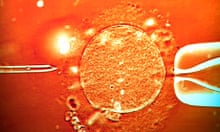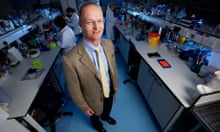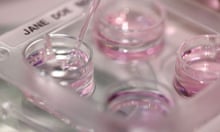Fertility specialists have developed a radical technique that can boost the chances of IVF couples having a healthy baby.
Doctors in Nottingham who devised the procedure say it could raise live birthrates at their clinic to 78%, around three times the national average for IVF treatment in the UK. Simon Fishel, director of the Care Fertility Group in Nottingham, said the £750 procedure was "probably the most exciting breakthrough we've had in 30 years".
The procedure is not available on the NHS, but Fishel said that could change once other clinics adopted the technology and showed that it could reduce the cost of fertility treatment.
Other specialists said the approach was promising, but cautioned that its effectiveness was uncertain without a full trial comparing it with other technologies.
The system monitors the health of embryos by taking thousands of digital pictures from the moment of creation to the day they are implanted in the womb. The sequence of images can help doctors spot embryos that are developing well, and are most likely to result in live births.
Fertility clinics around the world have begun to use incubators fitted with time-lapse imaging technology, but the Nottingham group is believed to be the first to show how it can improve birthrates. The embryos grow in the incubators for five days, during which 5,000 pictures are taken, revealing the various stages of their development.
A healthy human embryo should contain 23 pairs of chromosomes, but more than half have too many or too few. Most either fail to implant in the womb or miscarry later in the pregnancy, but others lead to children being born with Down's syndrome and other genetic disorders.
The Nottingham team found embryos with abnormal chromosomes reach two milestones in their development about six hours later than healthy embryos. The first milestone comes when the embryo starts to change from a dense bundle of cells into a tiny sac. The second comes when this sac becomes filled with fluid.
Based on their findings, the doctors developed a computer program that ranked embryos as low, medium or high risk for abnormal chromosomes.
To test the system, the doctors ran the program on time-lapse images of 88 embryos that had been recorded previously for 69 couples at the clinic. Some 61% of the embryos ranked as low risk for abnormal chromosomes led to live births, compared with none of those ranked as high risk. The study appears in the journal Reproductive BioMedicine Online.
If other fertility clinics find the technique works as well, the NHS may adopt it as standard, Fishel said. "I suspect this will be the only way we culture embryos in the future."
Martin Johnson, an editor of the journal, said: "This is a significant advance, but it is one which still needs more work."
Allan Pacey, lecturer in andrology at Sheffield University and chair of the British Fertility Society, said: "This paper is interesting because we really do need to make advances in selecting the best embryos created during IVF. The idea of monitoring embryo development more closely is being used increasingly in clinics around the world."
Clinics can check embryos for abnormal chromosomes by removing and screening one or two cells. Known as pre-implantation genetic screening, the technique costs about £2,500 at British clinics.
"This may well be the technique we have been waiting for to improve embryo selection and thus success in fertility treatment," said Sheena Lewis, professor of reproductive medicine at Queen's University Belfast. "It is certainly timely to develop new ways of looking at embryo health since we have been basing embryo choice on just cell number and shape since IVF began. Time-lapse imaging provides the opportunity to give continuous, detailed information on how the embryo is growing."
Stuart Lavery, director of IVF at Hammersmith hospital, said: "Time-lapse imaging of the early development of human embryos offers the exciting potential of a novel and non-invasive way of selecting the embryo with the greatest chance of implantation." But he added that a full trial comparing the technique with standard embryo selection techniques was needed. "Several IVF units around the country have already adopted time-lapse photography into their clinical service, this research adds to the evolving evidence base supporting its use," he said.
In Britain, one in seven couples trying for a baby experience difficulties in conceiving. On average only about 24% of IVF embryos implanted into women in the UK lead to live births and the outcome varies depending on the type of fertility problem involved and the age of the woman. Younger women tend to have healthier eggs, making the chances of conceiving higher. Almost a third (32.2%) of women under 35 who have IVF have babies as a result. But only 1.9% for women aged over 44 on IVF do so.










Comments (…)
Sign in or create your Guardian account to join the discussion